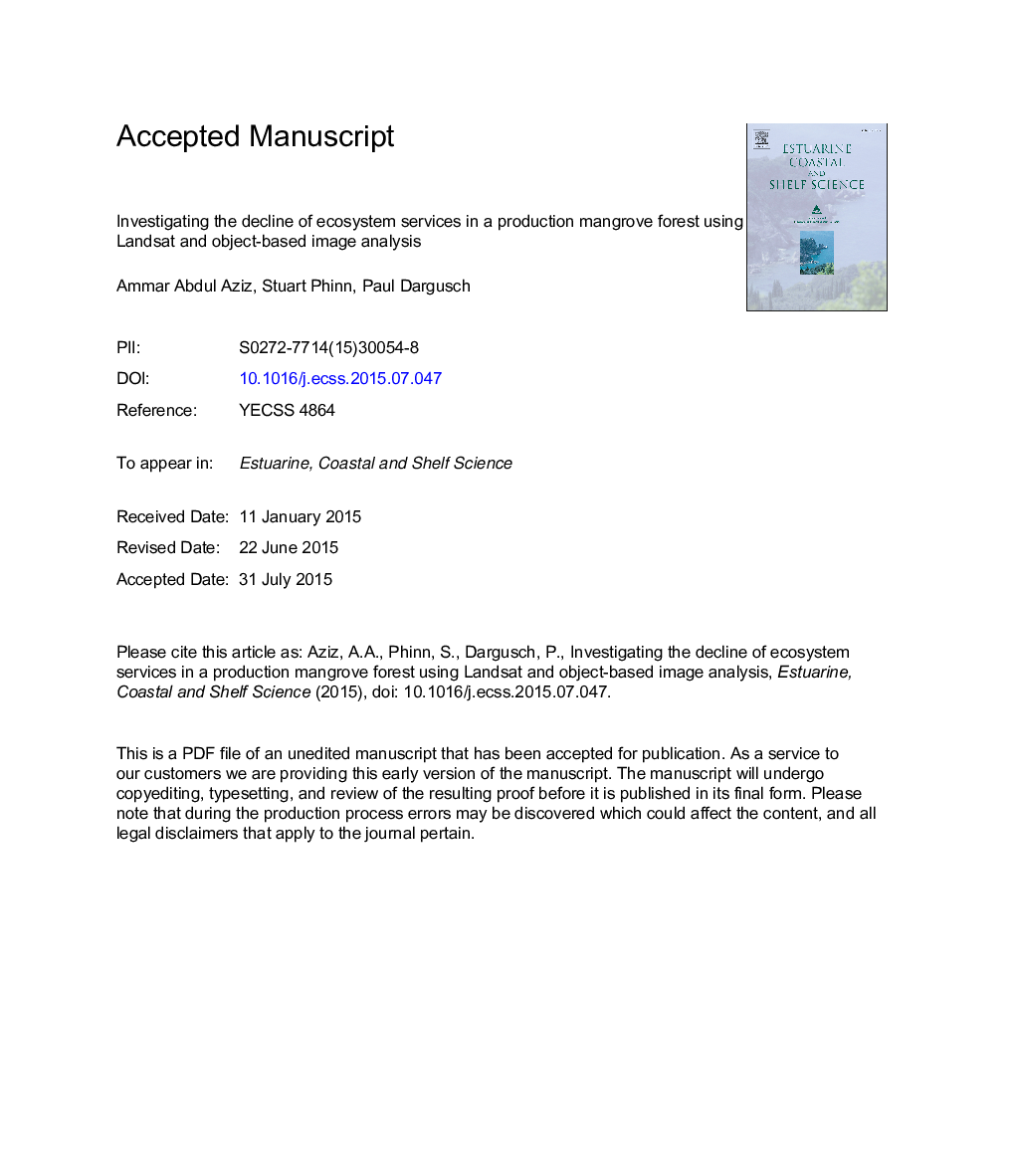| کد مقاله | کد نشریه | سال انتشار | مقاله انگلیسی | نسخه تمام متن |
|---|---|---|---|---|
| 6384719 | 1626633 | 2015 | 36 صفحه PDF | دانلود رایگان |
عنوان انگلیسی مقاله ISI
Investigating the decline of ecosystem services in a production mangrove forest using Landsat and object-based image analysis
ترجمه فارسی عنوان
بررسی کاهش خدمات اکوسیستم در یک جنگل انبه تولید با استفاده از لندست و تجزیه و تحلیل تصویر مبتنی بر شی
دانلود مقاله + سفارش ترجمه
دانلود مقاله ISI انگلیسی
رایگان برای ایرانیان
کلمات کلیدی
اکوسیستم، اثرات ناشی از انسان، صنعت جنگل، تعادل زیست محیطی، سنجش ماهواره،
ترجمه چکیده
ذخایر جنگلی مگنگ جنگل به طور گسترده ای به عنوان یک جنگل مانگرو مدیریت مداوم شناخته شده است. با این حال اخیرا شواهد در مورد کاهش خدمات اکوسیستم چندگانه ظهور کرده است. هدف اصلی این مطالعه استفاده از تکنیک های سنجش از دور به منظور ارزیابی تاثیر حوضچه های جنگلی در ذخایر جنگلی مانگرو در ارائه خدمات اکوسیستم است. این روش رویکرد مبتنی بر شیوه را برای طبقه بندی تصاویر چند لایه ای لندست اعمال کرد. تصاویر طبقه بندی شده این مطالعه را برای توصیف و تحلیل تغییرات فضایی و زمانی در توزیع ساختار و ساختار سنی در طول 35 سال انجام داد. لینک های بین تصاویر طبقه بندی شده و ارزیابی خدمات اکوسیستم بر اساس این فرض که نتایج طبقه بندی ارائه یک پروکسی قابل اعتماد برای تجزیه و تحلیل غیر مستقیم در توزیع زمانی و مکانی بیوماس زیرزمینی ذخایر جنگلی مانگرو ایجاد شده بود. رابطه بین اثرات بالقوه تغییرات مشاهده شده حاصل از تصاویر طبقه بندی شده با داده های به دست آمده از ارزیابی خدمات اکوسیستم مورد تجزیه و تحلیل قرار گرفت. تجزیه و تحلیل نشان داد که نوسانات عملکرد سبز درختان تحت تأثیر نرخهای مختلف بازسازی، قرار گرفتن در معرض تیره شدن بیش از حد و تاخیر در برداشت قرار دارد. تولید خس خس خشخاش در اطراف گلدان های ذخایر جنگلی مانگرو تحت تأثیر هر دو چوب استخراج چوب و فرسایش ساحلی طبیعی قرار دارد. تغییرات بوم شناختی ناشناخته در اواخر دهه هشتاد و اختلالات انسان شناسی، عوامل کلیدی در کاهش جمعیت طوفان شیری و ساحل دریایی مهاجر بودند. این مطالعه اهمیت فهم و مدیریت اختلاف بین تولید چوب و خدمات اکوسیستم در جنگل های مانگاری را برجسته می کند و مرجع مهمی برای مدیریت آینده جنگل های ممرف جنگل و سایر جنگل های تالاب چند منظوره است.
موضوعات مرتبط
مهندسی و علوم پایه
علوم زمین و سیارات
زمین شناسی
چکیده انگلیسی
The Matang Mangrove Forest Reserve is widely recognised as a sustainably managed mangrove forest. However, recently evidence of multiple ecosystem services decline has emerged. The primary objective of this study was to apply remote sensing techniques to assess the impact of the silviculture in the mangrove forest reserve on the provision of ecosystem services. It applied an object-based approach to classify multi-temporal Landsat imagery. The classified images enabled the study to characterise and analyse the spatiotemporal changes in the distribution of stand age composition and structure over a 35 year period. Links were established between the classified images and the ecosystem services assessment based on the assumption that the classification results provided a reliable proxy for an indirect analysis on the temporal and spatial distribution of aboveground biomass of the mangrove forest reserve. The relationship between the potential impacts of the observed changes derived from the classified images with the data obtained from the ecosystem services assessment were analysed. The analysis showed that the fluctuation in greenwood yield was affected by varying rates of regeneration, exposure to excessive thinning and delays in harvesting. The production of blood cockles around the mudflats of the mangrove forest reserve was determined to be influenced by both timber extraction and natural coastal erosion. An undetected ecological change in the late eighties and anthropogenic disturbances were possible key factors behind the decline in the population of the Milky Stork and migratory shorebirds. The study highlights the importance of understanding and managing the trade-offs between wood production and ecosystem services in a managed mangrove forest and provides an important reference for the future management of the Matang Forest Reserve and other multiple-use wetland forests.
ناشر
Database: Elsevier - ScienceDirect (ساینس دایرکت)
Journal: Estuarine, Coastal and Shelf Science - Volume 164, 5 October 2015, Pages 353-366
Journal: Estuarine, Coastal and Shelf Science - Volume 164, 5 October 2015, Pages 353-366
نویسندگان
Ammar Abdul Aziz, Stuart Phinn, Paul Dargusch,
